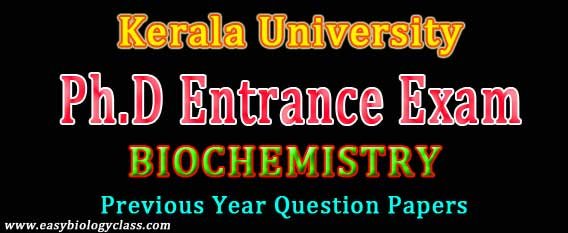
KERALA UNIVERSITY Ph.D. ENTRANCE EXAMINATION
NOVEMBER 2009
FACULTY OF APPLIED SCIENCES
BIOCHEMISTRY
Time: 140 Minutes Maximum Marks: 160
Note: Answer any twelve questions from Section B and one question from Section C in the subject concerned. In Section B, each question carries 10 marks. Section C carries 40 marks. In Section B an answer should not exceed 100 words. In Section C, an answer should not exceed 500 words.
SECTION – B
(1). What are ribozymes? Explain their characteristic activities.
(2). What are Telomeres? What are their characteristics? How are they synthesized?
(3). Briefly describe how X-ray diffraction technique has been employed to elucidate the structure function relation of ribosomes.
(4). Dietary deficiency of vitamin B1 leads to the disease beriberi. This is characterized by increased levels of pyruvate and alpha ketoglutarate in the blood. How does vitamin B1 deficiency account for this?
(5). Explain why familial hypercholesterolemia results in elevated levels of blood cholesterol.
(6). How is nitric oxide formed? How does it control vasodilation?
(7). Generally, plants have no need to produce urea; yet they contain almost all the enzymes of Urea cycle. Explain why?
(8). The amino acid sequence of a segment of a protein is-Met-Lys-Tyr-Ala-Asn-Gly-Ser-Val-Ser-Thr-Cys-Gly-. What are the possible post translational modifications that can occur in this segment of the protein and explain how it can occur?
(9). Illustrate with examples the feedback regulation of enzymes.
(10). Explain the molecular mechanism of the hypoglycemic effect of Insulin.
(11). Indicate the multiple pathways by which glucose-6- phosphate is metabolized and explain how the relative levels of ATP and AMP influence this.
(12). Describe the flow of electrons in the mitochondrial electron transport chain and explain how it is coupled to ATP formation.
(13). Explain the biochemical basis of I-cell disease.
(14). What are proteoglycans? Explain the structural features of chondroitin sulphate proteoglycan of the cartilage.
(15). Explain how PCR technique is employed to study gene expression.
(16). Explain the role of cyclins in cell cycle regulation.
SECTION – C
(1). A new protein has been identified. It appears to modulate the expression of a number of genes. Design a study to test this hypothesis.
(2). An enzyme X2Y2 that catalysis the reaction A + B ⇋ C + D, appears to be subject to allosteric regulation by a ligand L. Design an experiment to carryout kinetic analysis to demonstrate the allosteric property of the enzyme and to test the effect of the ligand.
(3). What are monoclonal antibodies? Explain how monoclonal antibodies are produced. Indicate their clinical applications.
Download this Question Paper as PDF File
Download link is provided below the PDF Preview…
